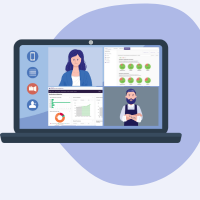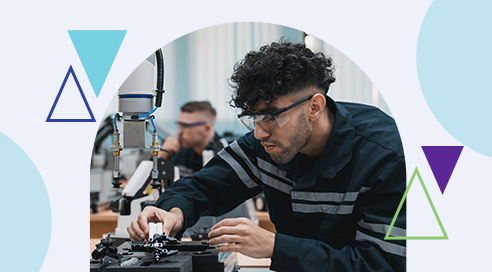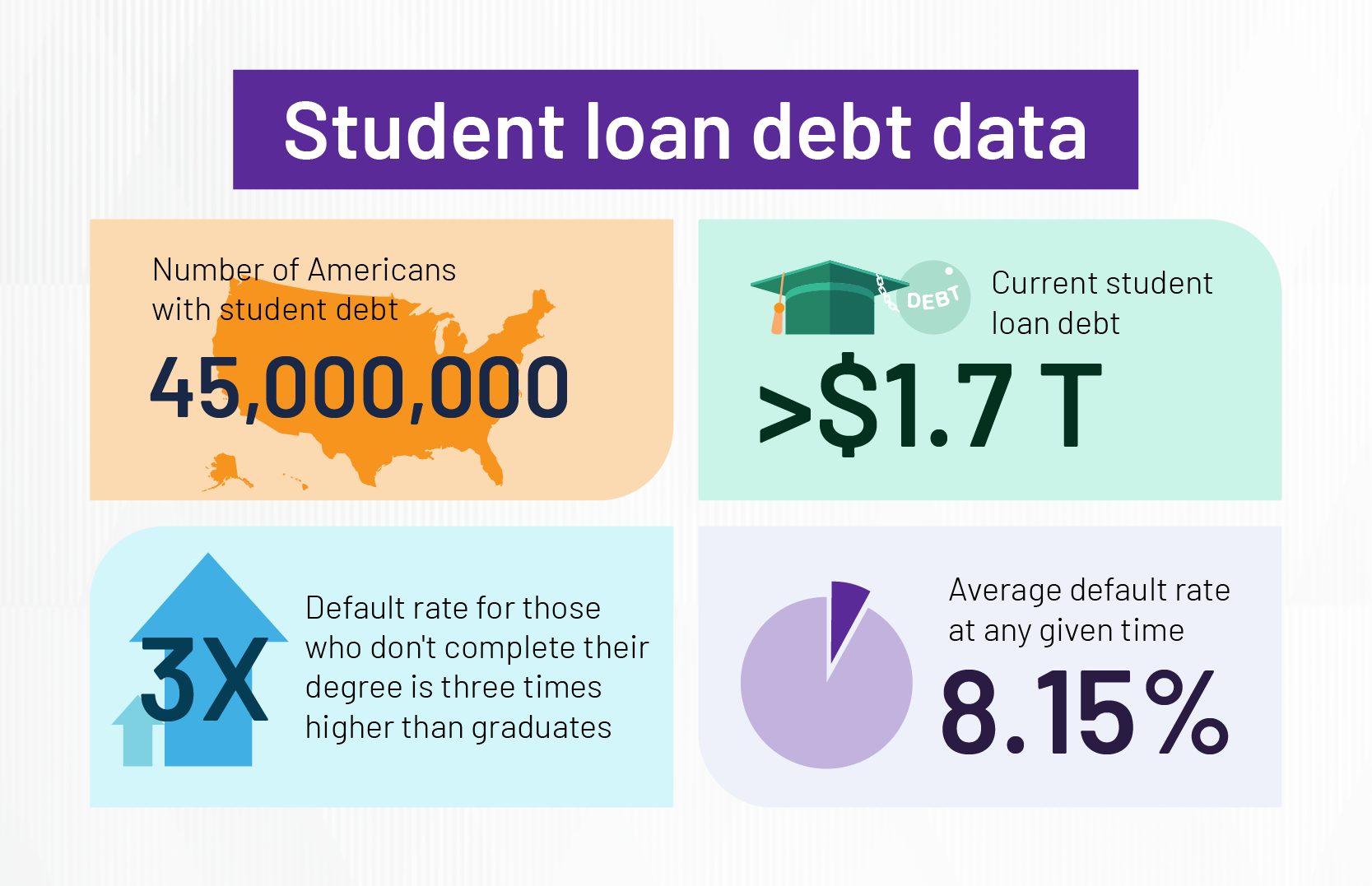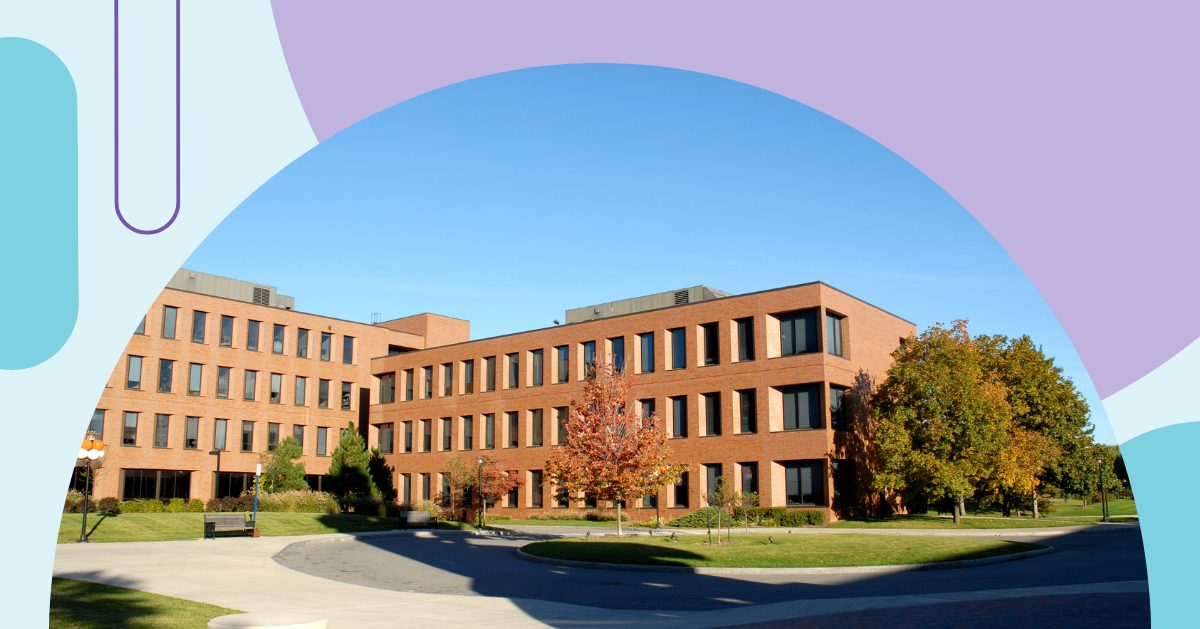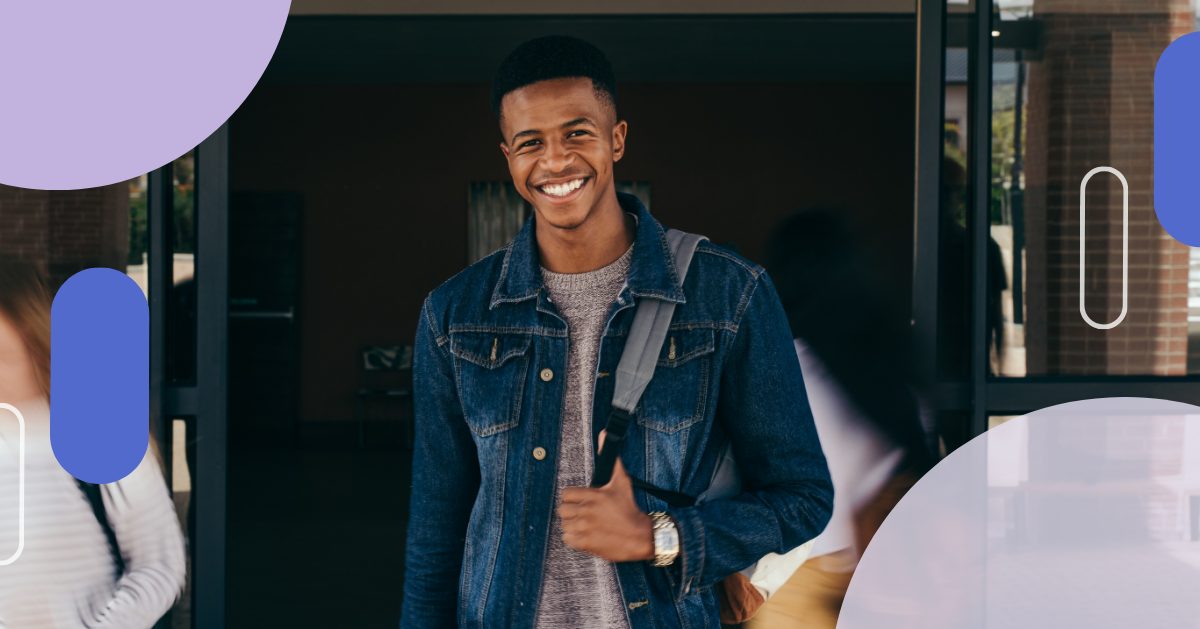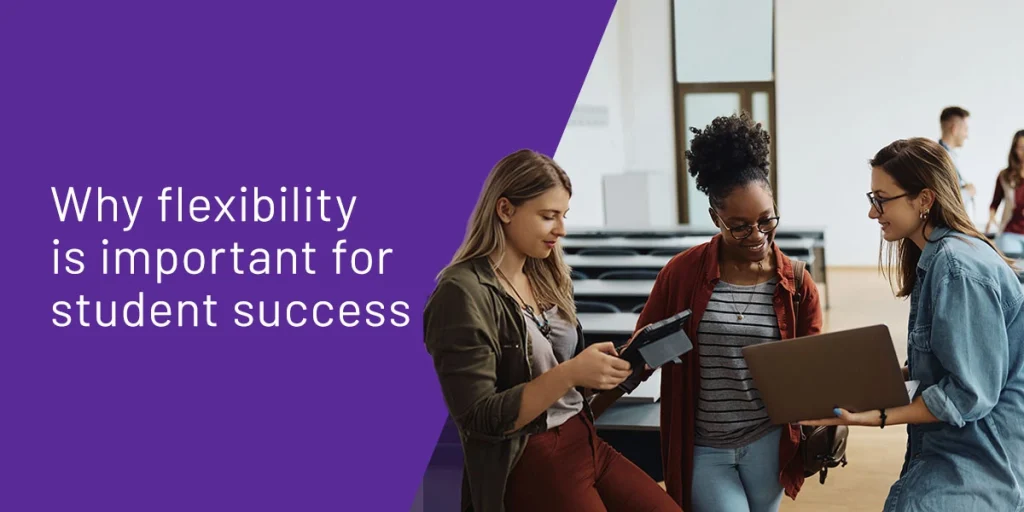
When it comes to flexibility, colleges and universities are rarely the places you’d expect to find it. Sadly, this rigidity is the reason many students drop out of school before completing their degree programs.
But things are changing, thanks to ongoing technological innovation and the rise of data-driven decision-making in higher ed. Taking advantage of new technologies can help your institution improve student retention rates, graduation rates, and more by unlocking more opportunities for flexibility in education.
What is flexibility in higher education?
In the context of higher education, flexibility refers to an institution’s ability to adapt its offerings to meet students’ needs while maintaining its high standard of academic rigor. Those adaptations could take many forms, from allowing students to submit an assignment late to building individualized courses of study for students with unique interests.
According to a recent survey by Inside Higher Ed and New Student Voice, some of the most important elements of flexibility include:
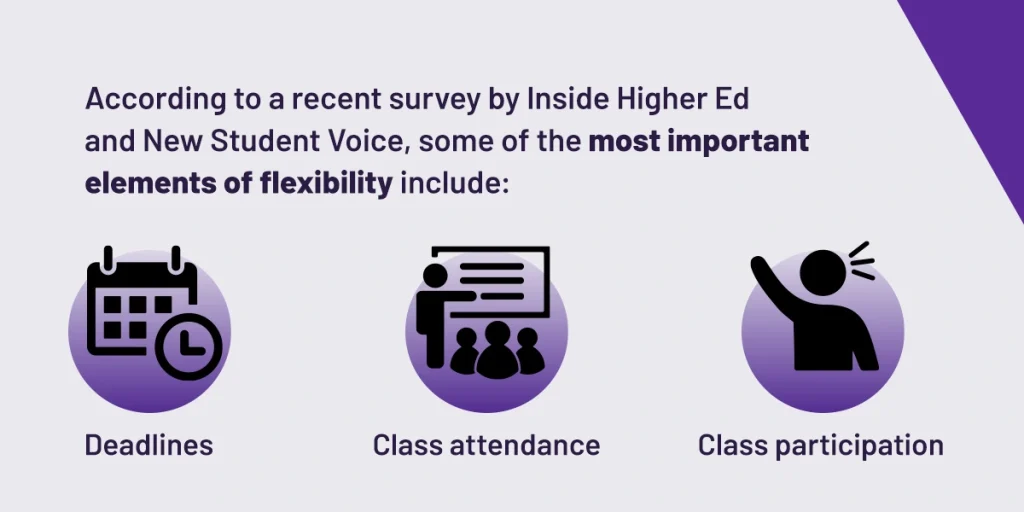
- Deadlines: The majority of respondents said flexible deadline policies should be available for students who experience extenuating circumstances, such as health issues and family emergencies. Some examples of successful deadline policies include allowing students to request extensions on assignments and providing one “free pass” per term.
- Class attendance: A flexible attendance policy should ensure students attend often enough to achieve the desired learning outcomes while enabling them to take care of life situations when they arise. That could mean missing anywhere from one to four classes per term without consequences, depending on the instructor.
- Class participation: Although many professors incorporate strict participation requirements into a student’s overall grade, experts say quality is far more important than quantity. Being flexible with what counts as participation can help instructors increase their educational impact by keeping students’ minds more engaged.
When flexible options are available, students have a better chance of staying engaged and achieving the learning outcomes they need to progress in their courses of study and, eventually, their careers.
The importance of flexibility for colleges and students
Providing a degree of flexibility is critical for maintaining high student engagement — a critical consideration for success. Flexible arrangements help re-engage students who are at risk of dropping out, especially in nontraditional populations such as veterans and working parents.
Other benefits of a flexible learning experience include:
- Improved retention rates: When your students are engaged with their education, they’re significantly more likely to finish their program within a reasonable amount of time. And because retaining students is often more profitable than enrolling new ones, boosting retention rates can help you improve your institution’s cash flow.
- Better student outcomes: Engaged students are interested in their studies and motivated to learn, which makes them more likely to achieve the desired academic and non-academic outcomes.
- Achieving educational equity: Students from diverse backgrounds often encounter barriers that can prevent them from progressing in their studies. Flexible arrangements can aid them in overcoming these challenges, creating a more equitable institution for all.
What could Watermark do for your institution?
How institutions can create a more flexible learning experience
Flexibility can come in many different forms, depending on the resources available to the institution, the preferences of the faculty or administrators involved, and the needs of the student. Ultimately, though, some degree of flexibility is essential for ensuring all students have the chance to shine.
Here are some realistic suggestions for how to offer flexibility to students from all backgrounds.
1. Add more variety to course delivery
Nontraditional students often have to juggle many different responsibilities in addition to their coursework, such as working full-time jobs and caring for family members.
Few of these students can attend in-person weekday classes unless they are offered in the evening — and if those classes aren’t available, they may be unable to complete their programs on time. Others may live far away from campus, making it difficult to attend in-person classes at all.
Providing flexibility in course structure and scheduling can help these students stay on track with their education even when their lives get chaotic. Some examples of how your institution can accommodate these students include:
- Evening and weekend classes: Night and weekend classes give students who work the chance to pursue their education without feeling like they need to quit their jobs or burden their families to do so. You could also bring in industry professionals who are busy during the week as guest instructors, providing opportunities for more value.
- Hybrid schedules: Hybrid courses combine the flexibility and autonomy of online learning with the personal engagement of attending in-person classes for both faculty and students. For example, a class that meets twice weekly could have one session in the classroom and one synchronous online lecture each week.
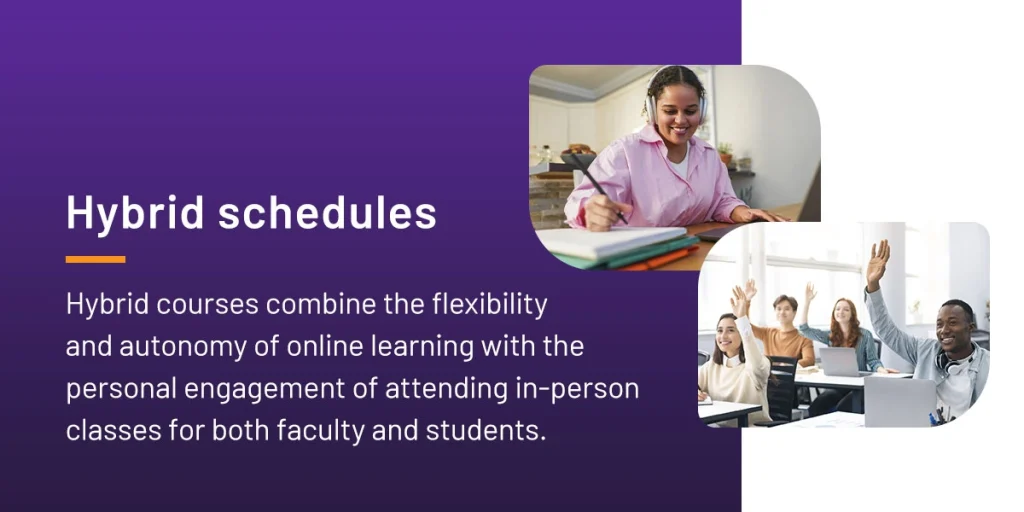
- Hyflex schedules: “Hybrid-flexible” (hyflex) courses allow students to choose which days they will attend classes in person or online, which gives them more time to handle other responsibilities without disrupting their studies.
- Asynchronous online courses: The self-paced nature of online education gives students the flexibility to fit their education into their schedules wherever they can. However, it’s important to remember that this format is only compatible with certain courses and academic disciplines — a fully online program rarely provides the same value as its hybrid or in-person counterpart.
2. Implement personalized learning options
It’s now common knowledge that everyone learns differently, and that each student has unique academic and career goals. And while the standard approach to education has seen few changes over the past few decades, it excludes many students.
“Personalized learning” is a newer trend in higher ed that helps students take charge of their education by building their own academic experiences. For example, students might meet one-on-one with an academic advisor or student success coach to create a program tailored to their specific interests, schedules, and career goals.
Student data is critical for implementing personalized learning. Insights from summative and formative assessment scores as well as behavioral observations can help faculty collaborate with students to create holistic, unique learning experiences that align with their educational goals and meet their needs.
Additionally, leveraging student success software enables advisors and student success team members to track student progress throughout their time at your institution, making it possible to support individualized programs for students of all backgrounds.
3. Offer mentor programs
Mentorship is a great way to introduce flexibility into your institution, especially for students from nontraditional backgrounds.
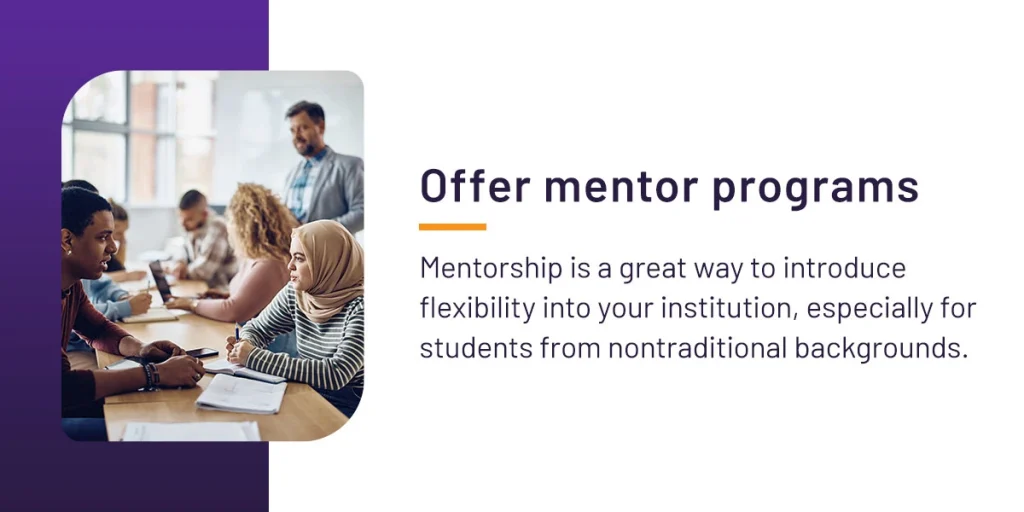
For example military students — including veterans and active-duty service members — often experience challenges in the transition from regimented military life to the self-paced culture of academia. They’re also usually older than traditional college students, with personal and professional responsibilities their peers don’t have.
This culture shock often makes military students feel isolated from their institutions, which can interfere with their ability to access the resources they need to help them get through their programs. Sometimes, the best way to accommodate these at-risk students is to provide opportunities to connect with their academic peers and faculty members.
Mentors can guide at-risk students toward helpful campus resources and provide valuable advice on maintaining a healthy school-life balance, choosing courses, working toward a promising career, and more.
4. Adapt classroom requirements
The greatest impact on student engagement comes from your faculty. Most students interact with their professors more than anyone else on campus, both in and out of the classroom, which builds a rapport and establishes a sense of trust.
As a result, instructors are the ones who are most often tasked with devising flexible arrangements for individual students. Faculty should be open to making accommodations every so often to help students who are struggling to stay on track, but it’s also important for them to strike a balance between academic rigor and flexibility.
Therefore, the degree of flexibility each professor can provide will vary depending on academic discipline, course requirements, department policies, and the instructor’s own preferences. Regular participation in a hands-on chemistry lab, for example, is significantly more important for achieving the desired learning outcomes than it is in an English literature seminar.
5. Connect institutional systems
Most institutions already use at least one form of digital educational technology (edtech), such as a learning management system (LMS).
And while these programs can help streamline learning for students, using multiple disparate systems can limit visibility into student records and reduce your ability to determine the best course of action for each student’s situation.
Creating communicative pathways between the software programs your institution uses can help you consolidate your tech stack and save some extra money that can be allocated to other areas of your institution.
Integrations with a native mobile app, for example, allow students to get in touch with their support team from anywhere, whether they’re on campus or at home. Student success coaches can check in via the cloud and monitor changes as they occur, providing total transparency for both parties.
6. Build a strong student success team
An institution’s student success program is more important than you may expect. Student success administrators, for instance, juggle a long list of responsibilities pertaining to enrollment, retention, institutional strategy, career coaching, and more each day.
However, many institutions lack the proper infrastructure and resources to support a robust student success program. Student success software equipped with predictive analytics and early notifications can help your student success team make a greater impact by:
- Identifying at-risk students: By analyzing historical student data from various sources, predictive analytics programs can uncover trends in student behavior that could indicate the student is struggling. For example, sudden drops in attendance or grade point average (GPA) are clear signs that a student needs help.
- Notifying faculty: Automated notifications loop your staff in when students face obstacles or change their foals, making it possible to respond before it’s too late.
- Prioritizing cases: Predictive analytics can identify which students are most at risk, enabling your staff to triage students for maximum effectiveness.
- Integrations: Integrations with the rest of your tech stack help create a single source of truth for all your student data, from grades in your LMS to internships and academic achievements listed in ePortfolios.
7. Invest in student success software
Often, one of the biggest obstacles to education for students is a lack of institutional transparency. Departmental data silos prevent administrators and faculty from getting a complete picture of each student, which can make it more difficult to identify if and when someone needs help, and determining whether accommodations are necessary becomes significantly more challenging.
That’s why implementing an advanced student success software solution is the best way to support greater flexibility in student learning. With powerful analytics and reporting capabilities, your student success department can quickly gain insights into what students may be dealing with, helping them devise suitable plans for overcoming those challenges and getting the student back on track.
Plus, a fully integrated solution enables you to consolidate your tech stack, which can help you eliminate technology your institution doesn’t need and save some extra money for other uses.
Case study: Fayetteville Technical Community College
Fayetteville Technical Community College (FTCC) in Fayetteville, North Carolina, is an excellent example of how prioritizing flexibility for students who have special needs can significantly improve outcomes.
FTCC has a large population of veteran and active-duty military students due to its proximity to Fort Liberty (formerly Fort Bragg), the world’s largest U.S. Army base by population. Because service members move from place to place so frequently, ensuring they have taken the necessary courses to progress in their studies is challenging without unified records.
The same goes for other nontraditional students, which make up a significant portion of the student body at many community colleges like FTCC.
Implementing student success software enabled FTCC to provide more flexible learning options to their students that had been near impossible before. By creating a single source of truth for all their student information, FTCC faculty and administrators gained greater visibility into the challenges students faced — which helped them develop individualized solutions to overcome them.
Now, though, when students need assistance, all their records are easily accessible from the program’s centralized, cloud-based hub. Where FTCC had once lacked a robust mandatory advising program, it now reaps the benefits of custom advising for individual students — and it’s all thanks to the power of their data.
Accommodate student needs with Watermark Student Success & Engagement
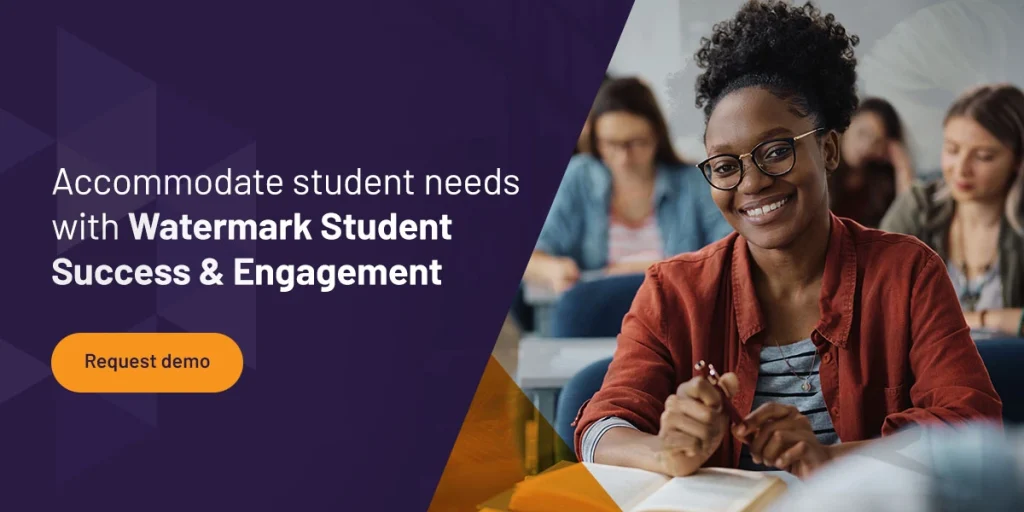
At Watermark, our mission is to help higher education institutions harness the power of data for continuous improvement in an increasingly complex world. Watermark Student Success & Engagement is an intuitive software solution designed to help improve student outcomes using the information your institution already collects.
Deep integrations with leading LMS and SIS as well as all other solutions in our Educational Impact Suite (EIS) create a single source of truth for seamless data transfer across your entire institution. Advanced predictive analytics capabilities analyze this data and flag signs of student disengagement, sending an automated alert to your student success team so they can intervene right away.
And our solution has proven results — within just one year, institutions that implemented Watermark saw a 6% increase in student retention.
If you’re ready to transform your student success operations, Watermark can help you through every step of the journey. Contact us today to request your personalized demo.


